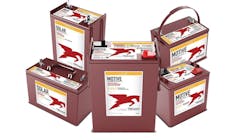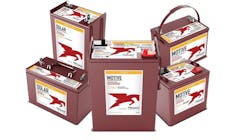New Design Techniques Extend Battery Life for Greater Pallet Jack ROI
Electric Class 3 pallet jacks are generally powered by one of three battery types: flooded lead acid (FLA), absorbed glass mat (AGM) or Lithium-ion. Which technology is best for material handling equipment, such as Class 3 electric pallet jacks, depends on the application and budget requirements of the customer.
Regardless of the environment in which they will operate, however, extending battery life is key to achieve optimal return on investment (ROI). Fortunately, new design techniques and technologies are helping attain that goal, which is also aided by implementing proper maintenance and storage practices.
Figure 1 outlines the key parameters of FLA, AES AGM (advanced AGM battery technology) and Lithium batteries. Lead acid batteries are the tried-and-true technology for powering electric pallet jacks, while lithium-ion is a newer technology gaining traction. FLA batteries are generally the battery of choice when price point is the main factor.
AES AGM batteries are also a cost-conscious option, but require less maintenance than FLA and can operate in extreme temperature environments. Lithium is well suited when the electric pallet jack operates in multiple shifts that require long run times and convenient charging. Lithium is also a wise choice if the machine will be used for more than 3-5 years.
New Generation of Battery Design
New technologies and techniques are being implemented in modern batteries that help extend performance over the life of the battery. One example is how optimized active materials, such as negative plate nano-carbon additives, are being used to enhance the positive plate and negative plate design. Mechanical strength is increased through the design for added durability to withstand the conditions in which pallet jacks often operate.
READ MORE: Lithium Forklift Batteries Find Second Life in Solar Energy Storage
Other design enhancements that help extend effective battery life are:
Low corroding Pb alloys. Pb-alloys are optimized for use as grid material for lead-acid batteries. Utilizing optimized Pb-based alloys creates multiple benefits, including lowering corrosion rates, reducing passivity and refining the crystal structure. The result is better battery performance and longer life.
Engineered additives. Advanced additives, such as carbon, prevent formation of a passive lead sulfate layer. Such additives greatly improve the cycle life of batteries and charge acceptance during operation. This is how AES AGM batteries can operate as efficiently and safely as traditional flooded lead-acid batteries, with the added ability to operate in Partial State-of-Charge (PSoC).
Traditional lead-acid type batteries in material handling applications suffer from one major drawback—they must be fully recharged after every cycle. When they are not brought back to a full state of charge following each cycle, stratification of the electrolyte and sulfation of the negative plate will lead to the premature failure of the cell and corrosion. Battery life is reduced and battery replacement is more frequent. Incorporating carbon in the AES AGM batteries’ negative electrodes helps stabilize and prevent the damage caused by not reaching a full state of charge. This allows users to charge only when power is available without fear of reducing battery life.
Advanced separator. High-performing flooded batteries incorporate an advanced separator design with a multi-rib geometry design (figure 2) to keep the acid channels open longer, enhancing the electrochemical process throughout the life of the battery. As these flooded lead acid batteries age, the positive grids and negative plates continue to expand, reducing the channels that allow passage of electrolyte.
The advanced separator design also incorporates a rubber-based material that inhibits antimony transfer between the positive grids and negative plates. Further, a thick back web provides exceptional separator strength for a more robust battery, with increased protection against failures caused by separator degradation while providing superior battery life.
Reduced cell resistance. Internal resistance is one parameter that indicates a battery’s ability to carry current. The higher the internal resistance, the greater the energy loss for any given current, which is converted into “heat” and contributes to battery degradation, as well as wastes energy. To offset this, certain lead acid batteries are optimized to enhance current flow through the grid network. Battery performance is significantly improved, downtime is reduced and maintenance and replacement costs are lowered.
Maintenance Techniques
Improved design techniques are vital to extending battery life, but it doesn’t mean that proper maintenance can be ignored. For lead acid batteries, maintaining proper water levels in the battery cells is the most significant factor in extending battery life.
For standard batteries, electrolyte levels should be 1/8 in. below the bottom of the vent well. The electrolyte should not drop below the top of the plates. Conversely, if a battery overflows, acid is lost, which will significantly shorten a battery’s life.
READ MORE: Striving for a Safer Lithium Battery
Water purity can have a major effect on battery performance and longevity. Distilled water is preferred, but deionized water and water from reverse osmosis are acceptable, as well.
The amount of dissolved solid contaminants determines water purity. Industry consensus is that the parts-per-million count should not exceed 100. The gassing effects from charging a storage battery concentrates mineral contaminates in the electrolyte solution. As a result, the minerals will have a cumulative effect inside the battery, which often accelerates aging reactions.
Again, battery design advances aid in maintenance to help ensure long battery life. For example, watering is not required in the AES AGM batteries (figure 3), eliminating this costly step.
Importance of Controlled Storage
Proper storage of deep-cycle batteries helps achieve better performance and longer life while increasing reliability and value. Lead acid batteries must be kept within a certain temperature range, or else they will have a shorter working life. Additionally, the batteries will become hot while charging, which requires them to be charged and stored in a temperature-controlled space.
READ MORE: R&D Spotlight: Stretchable, Flexible Li-Ion Batteries are a Natural Fit for Wearables
At higher temperatures, battery capacity generally increases, usually at the cost of battery life. A general rule of thumb is that every 10°C increase in temperature doubles aging and self-discharge reactions. Therefore, storing batteries in a hot environment accelerates the self-discharge characteristic, increasing maintenance costs.
At lower temperatures, battery capacity generally decreases. Further, as temperatures decrease, the rate of reaction decreases, slowing the self-discharge characteristic. Batteries stored outdoors may be subject to freezing, especially when stored in a discharged state. Freezing usually results in irreparable damage to the plates and containers. Batteries subjected to freezing temperatures should be stored fully charged or at a high state of charge to reduce the adverse effects.
Ensure Longevity
To ensure reliable operation and optimize ROI on electric pallet jacks, the proper battery must be installed, and the battery must be properly operated and maintained. While application plays a role in which technology is used, the one constant is advanced technologies and designs in a new generation of batteries ensure long operating life. Implementing proper and consistent maintenance practices also plays a role in battery longevity.
Darren Brittain is the senior director of Portfolio Strategy for Trojan Battery Company, bringing with him more than eight years of motive and industrial battery experience. He has over 20 years of business experience in the automotive aftermarket parts, heavy equipment, stored energy solutions and cloud/IoT markets.



